The U.S. economy may be sluggish, but the towing industry is showing signs of real vitality.
Towing vessel operators who had all but ceased ordering new vessels following the “Great Recession” that began in 2009, are once again moving to renew and expand their fleets.
Now the market is returning to more normal and perhaps more sustainable levels. Some operators may be trying to get ahead of new emissions regulations. Others are responding to the demands of customers for larger, more capable tugs. And many realize that it would be unwise to put off any longer replacing aging and inefficient vessels.
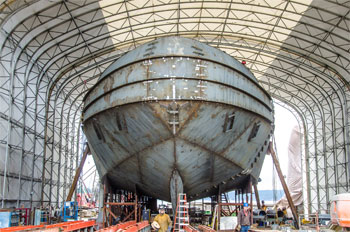 |
|
Brian Gauvin Harley Marine’s Ahbra Franco at Nichols Brothers Boat Builders. |
Robert G. Allan, the head of the naval architecture and marine engineering firm Robert Allan Ltd., observed that the level of new orders has not returned to the intoxicating levels of 2008. At that time, so many vessels were being built that the wait time for new marine diesels from manufacturers was as much as two years. When the market headed downhill, a lot of planned tugs never got built and their engines went unused. “A lot of those engine are now on the block,” he said.
“There was all sorts of speculative building. No one was ordering one of anything,” Allan continued. “It was really an overheated time. Now is nothing compared to those crazy days.”
Allan is executive chairman of his firm, which is based in Vancouver, British Columbia. Under his leadership the company has emerged as one of the leading tug design firms in the world, with a 35 to 40 percent market share. “We’re trying for 50,” he said.
As a designer of custom tugs with an international focus, Allan is well positioned to assess the market. And what he sees is relatively encouraging.
“The market has stabilized. It’s strong and fairly healthy,” he said.
That’s not to say that every sector of the industry is doing great. The offshore oil industry is “off the bottom but nothing near to what it was,” according to Frank J. Basile, the president of Entech & Associates, a design firm based in Houma, La. On the other hand, “The brown water industry is going crazy.” Almost all the builders of towboats along the Gulf of Mexico are busy, Basile said.
Given the overall state of the U.S. economy, the rebound in the towing sector can seem a bit puzzling. During the first part of 2012, the U.S. economy seemed to be getting onto a firmer footing. The annualized rate of growth during the first quarter was 2 percent, then dipped a bit to 1.3 percent in the second. Things brightened in the third quarter when the rate spurted to 3.1 percent. But by the end of the year the growth rate had fallen to an anemic 0.4 percent. In the first quarter of 2013, the economy speeded up to a growth rate of 2.1 percent, a figure that is still well below the long-term average since World War II of 3.2 percent.
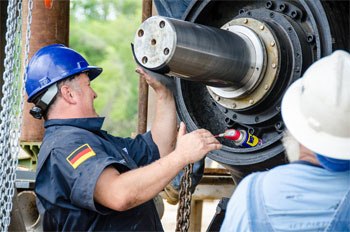 |
|
Brian Gauvin A technician installs a propeller at LeeVac. |
Bruce Washburn, executive vice president of Washburn & Doughty Associates, which operates a shipyard in East Boothbay, Maine, sees a disconnect between the slow national economy and the good health of his own shipbuilding business, which is getting close to the busiest it has ever been in the 36 years of its existence.
“It is hard to say how much the economy is driving that,” Washburn said. “The last time the economy was this bad, there were no tugs” being built.
So what is going on? The answer includes many forces.
One may be the impending opening of the new locks in the Panama Canal. Instead of unloading their cargoes at U.S. West Coast ports, containerships as long as 1,200 feet with a beam of 160 feet will be able to pass through the bigger locks to reach ports on the U.S. Gulf and Atlantic. These ships, while far from the biggest containerships afloat, will nevertheless have more than double the carrying capacity of the largest Panamax vessels. That prospect has Eastern and Southern ports drooling at the prospect of handling much larger shares of the huge volume of goods manufactured in the Far East and sold to North American consumers. So ports are scurrying to deepen their channels and buy cranes capable of loading and unloading these much larger ships, while tug operators are looking to acquire bigger, more powerful docking and escort tugs.
“The Panama Canal has got people thinking bigger ships are coming to this coast,” said Washburn.
And bigger ships require bigger tugs. “Before, 5,000 hp seemed to be the range everyone was settling in on,” Washburn said. But now operators are thinking about 6,000-hp docking tugs.
Washburn & Doughty is building a 6,000-hp tug for Moran that is due for completion in late 2013 or early 2014. “I am not sure where this one is going,” Washburn said.
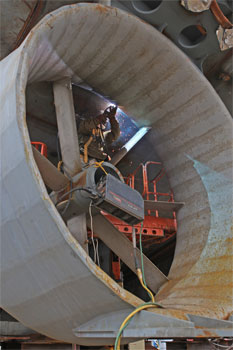 |
|
Rod Smith A worker puts the finishing touches on a nozzle of an ATB under construction at Senesco Marine. |
In addition to greater horsepower, tug operators are also looking for a bit of escort ability in their docking tugs, according to Washburn. “Most of the boats these days are looking for some kind of escort capabilities” even though almost all their time is spent docking rather than escorting, he said.
As a result, Washburn & Doughty has been designing tugs with hulls that are more suited to waters beyond the confines of harbors. “These hulls can operate in a little more open water,” he said.
Competitive forces and changing markets influence what vessel owners want in their tugs. But government regulations are often powerful drivers. And changing engine emission requirements have been a huge influence in recent years. Impending stricter regulations may be having a strong impact now even though they have yet to take legal effect.
Meeting progressively stricter emission standards has been a challenge for engine makers, builders and operators alike. “In the last few years we’ve been kind of hammered by new levels of emission standards,” Washburn said.
U.S. Environmental Protection Agency Tier 3 standards currently apply for most vessels. Tier 4 regulations will begin to take effect for some classes in 2014. Some manufacturers will use after-treatment technology to meet those new standards. That means engines will be equipped with systems that inject urea into the exhaust to reduce pollutants.
Washburn thinks that approach will raise some difficult issues for tugboat designers and operators.
“Tier 4 is a big question,” he said.
Washburn suspects that some operators may be hoping to avoid the problems by pushing ahead now in order to get their new tugs built before the Tier 4 standards come into force.
The after-treatment equipment will be almost the same size as the engine, he explained. “Getting the same power in the same envelope is going to be difficult.”
There will be technical problems that will be particularly acute for tugs because of the nature of their work. Their engines typically operate at high power settings only for short periods of time when they are actually moving or guiding a large ship. The rest of the time they are idling or moving at low speed to or from a job. That means a wide range in their stack temperature. And the urea treatment systems require relatively high stack temperatures to work properly. According to Washburn it may be difficult for tugs to maintain adequate stack temperatures.
“Tier 4 is going to start affecting design,” Washburn said.
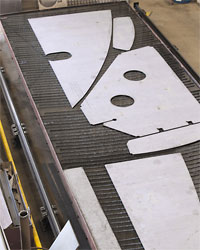 |
|
John Snyder Cut steel sections await assembly at Washburn & Doughty. |
Allan agrees. He says that the design problems posed by the Tier 4 regulations have a straightforward solution.
“That’s easy. Just make the boats bigger. Does that make sense? Not really,” he said. “It’s not a challenge to design a tug big enough to carry the gear. The challenge is to build one that operates economically.”
Given the problems, operators may opt for alternatives to after-treatment, such as LNG-fueled boats or diesel electrics. LNG would eliminate the need for urea treatment. And diesel electric boats could have multiple generators, solving the problem of variable-load cycles for the main engines. But those approaches have their own sets of problems, such as sufficient fuel storage space and range for LNG boats and higher capital costs for diesel electrics.
“It’s a very interesting time in the tug world,” Allan said.
It is also an exciting time for some operators. Harley Marine Services, the parent of companies that operate on the West, East and Gulf coasts, has three new ASD tugs and one ocean-towing tug coming into service this year. It also has six new towboats in the 2,000 to 4,000 hp range under construction and two more planned.
Harley Franco, the company’s chairman and president, observed wryly about this ambitious building program, “What a way to go broke.” But of course, he sees these newbuilds as a wise investment. “The marketplace hasn’t kept pace with the need,” he said.
In this economy, there may not be an obvious need for more ASD tugs, but there is a need for bigger ones, Franco said. The ships to be docked and escorted are getting bigger and pilot groups want more powerful tugs to control the ships safely and efficiently. “Certain pilotages require more bollard pull,” he said.
And he expects to build even more ASD tugs. He noted that Harley has two 4,000-hp tugs built about a decade ago that are now operating in the Los Angeles area. He hopes to build new ones that would be about the same length (just under 80 feet) but would be beamier and more powerful, at about 5,000 hp.
In addition to ship-assist work, Harley is also a big player in the movement of oil. And that sector is growing. “There’s a lot of things happening in the energy sector,” he said, noting growing exports of crude oil from Canada and growing oil production in the United States. “We’re part of a floating pipeline.”
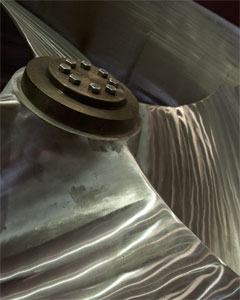 |
|
John Snyder
The propeller of an azimuthing stern drive for a tug at Washburn & Doughty. |
The company’s plans include building several 80,000-barrel ATBs. As Canadian and U.S. crude production increases, Harley expects to be moving more petroleum products to market. “We’re part of that process,” he said.
This is all good news not just for the builders of tugs, but for towing equipment manufacturers as well. Scott Kreis, vice president of sales with Markey Machinery in Seattle, said his company has seen a surge in business compared with a few years ago. “We have a robust order book,” he said.
Kreis said he has witnessed cyclical declines in the towing industry in the past; eventually pent up demand compels operators to move ahead with new tugs and gear. “You patch things up for as long as you can. Ultimately that need doesn’t go away,” he said. “We see boats being built. That’s something a couple of years ago, you couldn’t say.”

